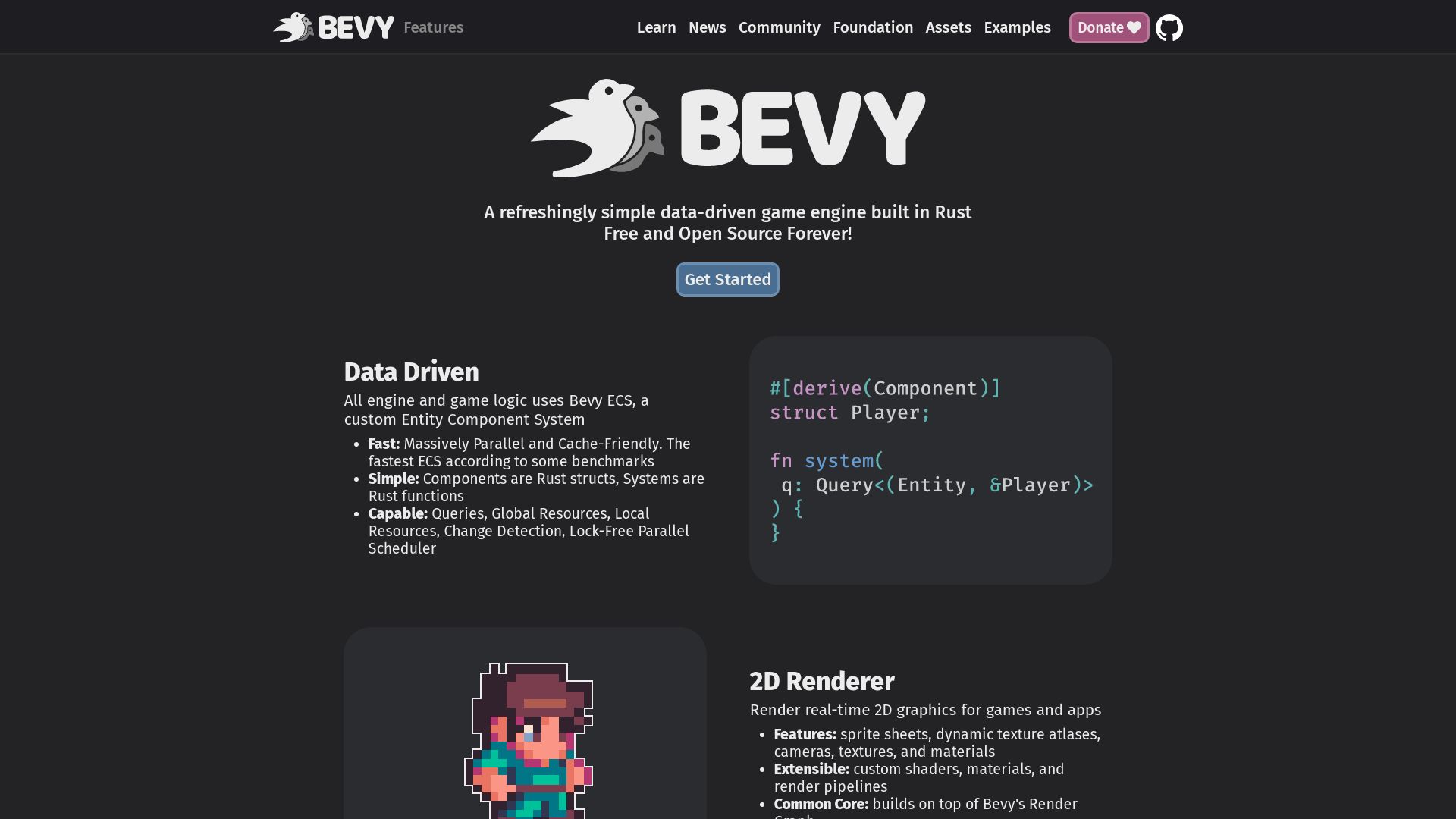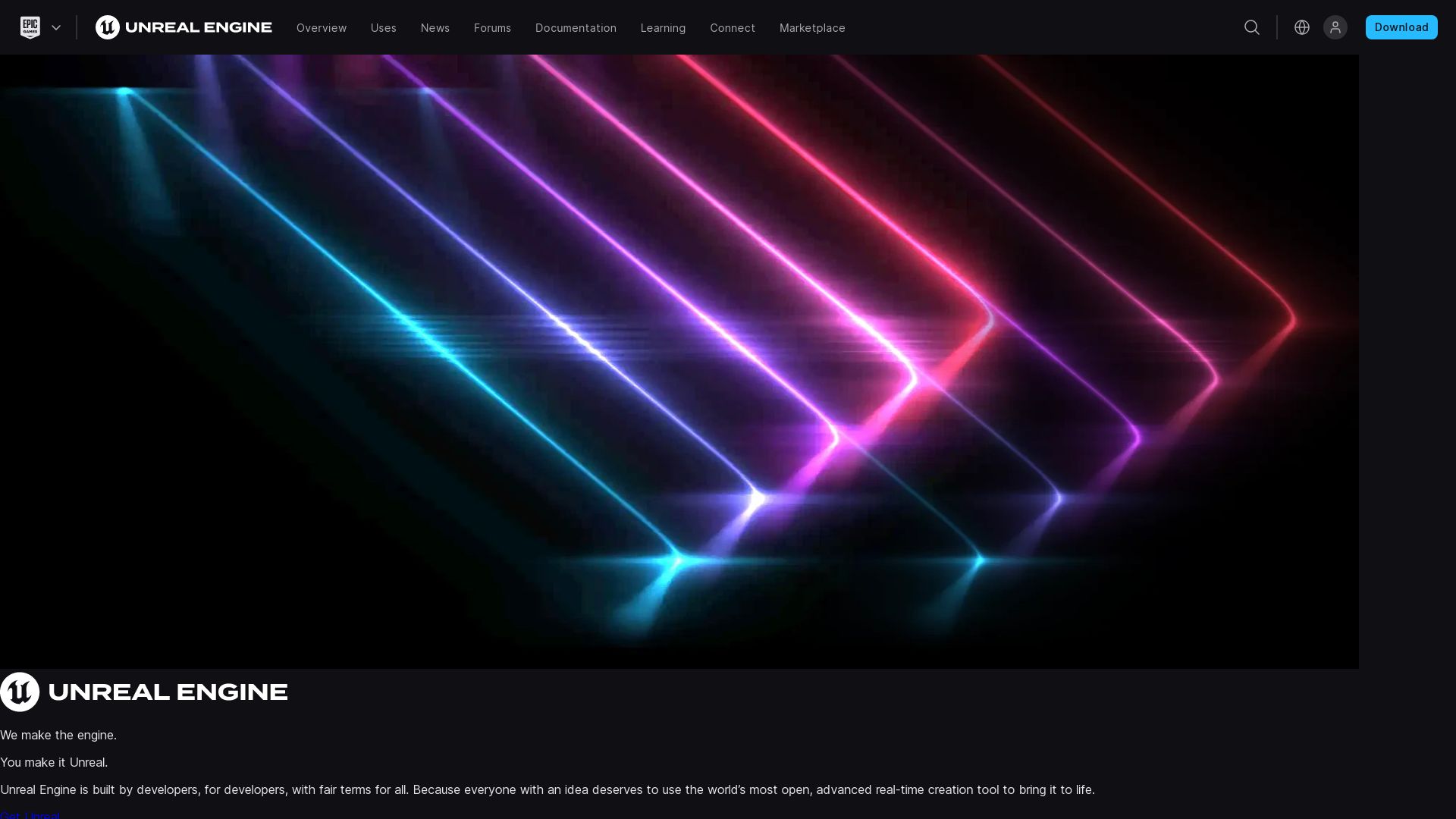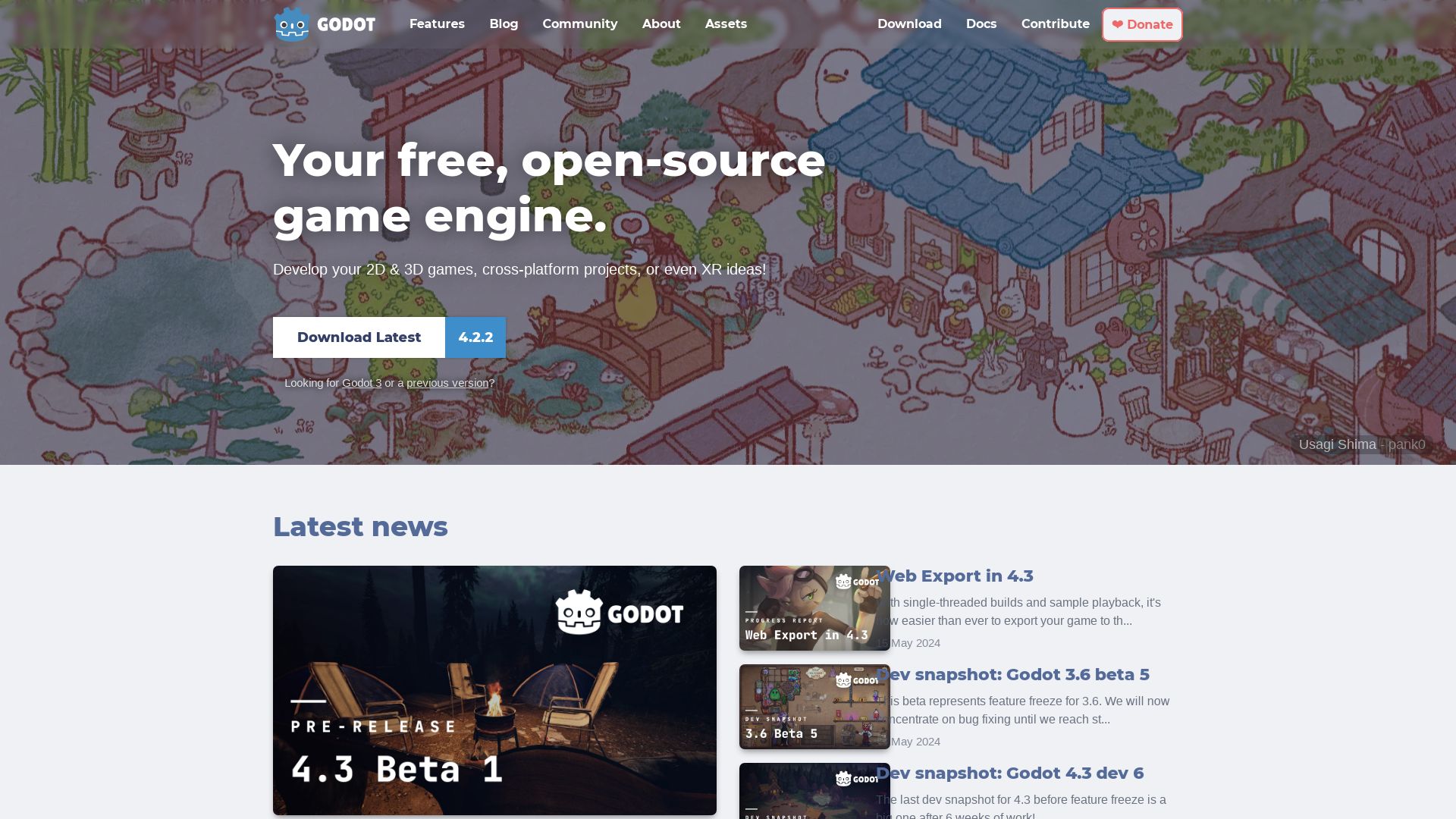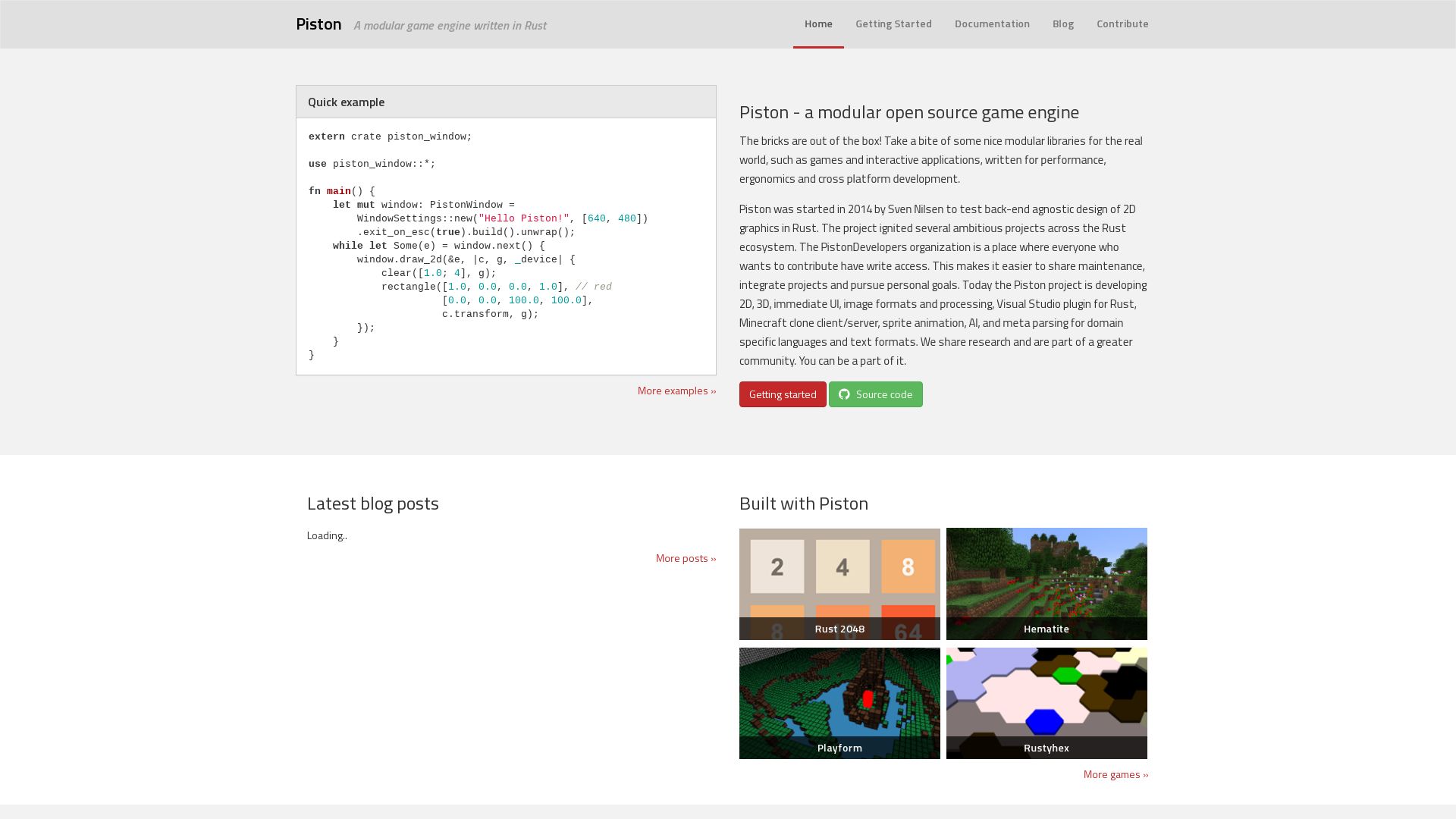Brilliant is a leading educational platform founded in 2012 by Sue Khim, focusing on STEM topics. It offers over 100 guided courses crafted by professionals from institutions like MIT and Google. Gamified learning and strong visual aids make complex concepts easy to grasp. With a user base exceeding 4 million, Brilliant is renowned for its problem-solving-based courses and engaging daily challenges.

If you’re exploring options beyond Brilliant, consider Bevy, Amethyst, Boundless, Unreal Engine, Fyrox, Raylib, Godot, Macroquad, Piston.
Bevy

Bevy, a robust data-driven game engine, is powered by the versatile programming language Rust. Designed to offer comprehensive 2D and 3D features, it capitalises on the strengths of data-oriented architecture via the Entity Component System (ECS).
Bevy Top Features
- Comprehensive Rendering: Offers both 2D and 3D rendering capabilities.
- User Interface Functionality: Creates interactive gaming experiences.
- Hot Reloading: Immediate feedback on changes, reducing development time.
- Quick Compile Time: Reported to compile between 0.8-3.0 seconds with ‘fast compiles’ configuration.
| Platform Support | Community |
|---|---|
| Supports Windows, MacOS, Linux, Web, iOS with future Android support. | Discord server, subreddit, GitHub Discussions. |
| Plans for high-level and low-level networking support, and Bevy-powered editor. | Assets collection and dedicated cargo features. |
Bevy Limitations
- Dependent on Rust language and compiler improvements resulting in potential API-breaking changes.
- Modern web standards such as wasm and webgpu are future considerations, but not yet implemented.
Bevy Pricing
Bevy is open-source, free, and licensed under MIT or Apache 2.0 licenses.
Bevy Use Cases
Use case 1
Indie game developers and enthusiasts can benefit from Bevy’s advanced features and ease of use.
Use case 2
In the future, larger studios may find Bevy appealing due to its comprehensive feature set and ongoing advancements.
Amethyst
Introducing Amethyst, an emergent data-driven and data-oriented game engine. Amethyst prides itself on being beginner-friendly, with features suitable for 2D and 3D game creation and experimentation. While its development has currently halted, it has previously thrived on its massively parallel architecture, its Entity Component System (ECS), and its compatibility with Rust 1.47.
Amethyst Top Features
- Data-driven and data-oriented design
- Utilizes massively parallel architecture and ECS
- Rusty Object Notation (RON) usage
- Potential for rapid prototyping
- Strong focus on reusability and clean interfaces
- Includes documentation for user-friendly operation
- Community support through Discord
- Capable of creating both 2D and 3D games
| Feature | Benefit |
|---|---|
| Data-driven design | Allows for behavior built by feeding data created by artists and game designers. |
| Rust compatibility | Advantages include concurrency and suitability for game development. |
| Reusability and clean interfaces | Provides efficient design experience and faster development time. |
Amethyst Downsides
- Development currently halted
- Considered pre-release; still in development
- Not recommended for large, commercial projects due to current developmental stage
- Criticized for being a general-purpose engine without a specific game
Amethyst Use Cases
Use case 1: Rapid Prototyping
The Amethyst game engine is ideal for rapid prototyping due to its data-driven design principles and potential reusability of assets.
Use case 2: Beginner Game Developers
Offering a user-friendly experience, coupled with robust documentation and community support, Amethyst is an excellent platform for budding developers looking to hone their skills.
Use case 3: Experimental Game Development
Though not yet ideal for commercial projects, Amethyst provides a fertile ground for developers wishing to explore efficient game development through ECS paradigm and RON usage.
Boundless

Boundless is an innovative company with a sharp focus on Augmented Reality (AR), Virtual Reality (VR), and Extended Reality (XR) technologies. Significantly transforming various industries such as architecture, real estate, healthcare, manufacturing, engineering, and education, Boundless is an avant-garde player in the realm of immersive technologies.
Boundless Top Features
- Immersive visualization of architectural designs and real estate properties via AR/VR technologies.
- Real-time practice for surgeons on complex procedures, thus minimizing risks.
- Interactive learning experiences for education, making remote learning more feasible and engaging.
- Optimization of production processes in industries through AR/VR, streamlining operations.
- Apple Vision Pro, an AR development platform enabling immersive AR experiences.
| VR/AR Uses | Benefits |
|---|---|
| Entertainment, Gaming | Increased engagement, better information retention |
| Education | Improved learning outcomes, interactive learning experience |
| Healthcare, Remote Collaboration | Realistic hands-on experience, reduced procedural risks |
Boundless Limitations
- Cost and access to technology
- Requires skilled educators for effective execution
- Technology complexity
Boundless Pricing
Specific pricing details for Boundless are currently not disclosed. Info seekers can contact Boundless directly for pertinent pricing inquiries.
Boundless Use Cases
Use case 1 – Architecture/Real Estate
Boundless’s AR/VR technology allows architects and property developers to present immersive visualizations to potential buyers, greatly enhancing decision-making processes.
Use case 2 – Healthcare
Boundless’s technology provides an opportunity for surgeons and students to practice complex procedures virtually, thereby reducing risks and augmenting the quality of medical care.
Use case 3 – Education
With Boundless’s AR/VR solutions, educators can create interactive learning experiences for students, making remote learning effective, engaging, and more feasible.
Unreal Engine

Join us on an exploration into the realms of Unreal Engine. Unveiled by Epic Games in 1998, Unreal Engine has evolved into a dynamic tool, spanning multiple platforms and genres, and even finding use in the film and television industry.
Unreal Engine Top Features
- Flexibility: Unreal Engine supports a wide gamut of platforms, including PCs, mobiles, consoles, and VR platforms. From first-person shooters to complex virtual interfaces, it’s a development powerhouse.
- Real-time Geometry Operations: Armed with UnrealEd, developers can perform real-time constructive solid geometry operations.
- Community Support: Unreal Engine Marketplace empowers developers to sell their creations or purchase work of others, fostering a vibrant, collaborative ecosystem.
| Collaborative tool | Unreal Engine 3’s openness fosters a rich community for mod developers. |
| Development Opportunities | Unreal Development Kit, a free version of Unreal Engine 3, supports creation of iOS games and apps. |
| Inclusive Education | Unreal Engine is provided free for schools and universities, bridging the digital divide in technological education. |
Unreal Engine Limitations
- The royalty model may not suit all developers. Epic charges 5% of revenues over USD 1 million, though waived for games published on Epic Games Store.
- Unreal Engine primarily uses C++. Developers less proficient in this language may face a steep learning curve.
Unreal Engine Pricing
While the Unreal Engine is free to use for education and includes basic project templates, commercial projects yielding a revenue over $1,000,000 are subject to 5% royalty charges by Epic Games.
Unreal Engine Use Cases
Use case 1: Game Development
Unreal Engine’s wide platform support makes it an excellent choice for game developers looking to create rich, immersive experiences across various genres and platforms.
Use case 2: Film and Television
With its 3D computer graphics capabilities, Unreal Engine has found fertile ground beyond game development, playing a crucial role in modern film and television production.
Use case 3: Education
Coding and digital creation have become essential skills in our digital age. Unreal Engine’s free access for schools and universities makes it a valuable educational resource.
Fyrox
Fyrox, originally named rg3d, is a vigorous 2D/3D game engine crafted with Rust known for its native editor akin to Godot. Impressively, it promises seamless cross-platform compatibility inclusive of Windows, Linux, macOS, WebAssembly, and Android.
Fyrox Top Features
- Advanced Asset Manager: Seamless management of assets including 3D models, textures, sounds, and custom assets
- Dynamic Model Instantiation: Functionality for animating mutable models.
- Animation Blending: Incorporates root motion, blend space, and blend shapes for dynamic 3D mesh changes.
- Audio Enhancements: Encompasses audio buses, audio bus graph for superior sound modulation.
| Format Support | Unique Features |
|---|---|
| Textures: PNG, JPG, TGA, DDS. Models Loader: FBX. Audio: WAV, OGG. | Special animation techniques for root motion. Blend space for blending animations. |
| Compressed textures (DXT1, DXT3, DTX5). | Compound rules for ABSM Transitions. Support for hashmap for animation system. |
Fyrox Limitations
- Missing details on community support platforms like Discord, Patreon, Boosty.
- Dependency on external sources for tutorials and guides.
Fyrox Pricing
As of now, there are no explicit pricing details mentioned for Fyrox. It is recommended to explore the official Fyrox book or online resources for more information.
Fyrox Use Cases
Use case 1 – Cross-Platform Game Development
Fyrox’s versatile compatibility makes it an optimal choice for developers seeking to deploy games across multiple platforms.
Use case 2 – Extensive Sound Options
Considering the advanced audio features, Fyrox appears to be a strong game engine for audio-rich gaming applications.
Use case 3 – Complex Animations
Fyrox’s advanced functionalities for animation blending and dynamic model instantiation make it ideal for games demanding intricate animations.
Raylib
Developed by Ramon Santamaria, Raylib was birthed in November 2013 as an innovative technology primarily focused on prototyping, graphical applications and educational projects. Written in C, it was designed with a cross-platform functionality spanning the likes of Windows, Linux, macOS, and even Android and Raspberry Pi. Drawing inspiration from the Borland BGI graphics library and the XNA framework, Raylib also boasts a universal appeal with bindings for over 50 programming languages.
Raylib Top Features
- No external dependencies: All necessary libraries are included.
- Supports multiple texture formats including compressed ones.
- Oriented towards both 2D and 3D design, with powerful 3D support for shapes, models and more.
- Hardware accelerated with OpenGL utilizing a unique OpenGL abstraction layer: rlgl.
- Robust shaders support including for models and postprocessing effects.
- Advanced Math module for vector, matrix and quaternion operations.
- Audio loading and streaming support with various formats.
- VR stereo rendering support with configurable HMD device parameters.
- Recognized with awards from Google and Epic Games.
| Feature | Description |
|---|---|
| Raygui | An immediate mode GUI module specially designed for Raylib. |
| Fonts module | Features SpriteFonts, BMfonts, TTF, SDF, catering to diverse typographic needs. |
| Materials system | A flexible system that supports classic and PBR maps. |
Raylib Limitations
- Raylib, being written in C, might present a higher learning curve for coders inexperienced with the language.
- Some developers might find the library’s intense focus on no external dependencies limiting for certain projects.
Raylib Pricing
One of the notable highlights of Raylib is its foundation in open source. This essentially allows developers everywhere to access and leverage the engine without bearing any cost.
Raylib Use Cases
Use Case 1: Game Development Education
With its foundational orientation towards education, Raylib serves as a proficient tool for faculties globally to teach videogame programming concepts.
Use Case 2: Prototyping
Developers seeking a quick cross-platform solution for game prototypes will find Raylib’s inclusive toolkit extremely beneficial.
Use Case 3: Tool Development
Given Raylib’s comprehensive feature set from graphical to audio manipulation, it is aptly suited for creating tools in the game development process.
Godot

Meet Godot, the iconic open-source game engine offering an intuitive design space for creating immersive games. Fueling creativity using a simple yet robust node and scene system, Godot makes game development accessible and innovative.
Godot’s Top Features
- Open-source: Boasting a modifiable codebase, Godot encourages modding and contributions from its lively community.
- Scene-Driven Design: By allowing the creation of games from simple blocks and combining scenes into full-featured components, Godot fosters a streamlined development process.
- Versatile Scripting Languages: From its lightweight, Python-like GDScript to robust C++ and C#, developers have a variety of languages at their disposal. Community support extends to languages like Rust, Nim and more.
- Cross-Platform: Create games for a range of platforms including Windows, macOS, Linux and even Android devices.
- 3D & 2D: Whether you’re crafting a nuanced 3D experience or a sprite-based 2D game, Godot provides you with refined workflows for both.
| Feature | Description |
| Visual Editor | Embedded within the engine, the visual editor facilitates coding, debugging, and profiling in real-time. |
| Audio Bus | Real-time audio effects, enhancing player immersion through careful sound design. |
| Storage Solution | Designed for team collaboration, accommodating shared development efforts. |
Godot’s Limitations
- Limited support for complex 3D game development
- .NET platform only available for desktop platforms
- Dependent on community for support for non-primary languages
Godot Pricing
Godot is completely free under the MIT license. There are no contracts, hidden fees, or licensing costs, making Godot a cost-effective choice for developers at all levels.
Godot Use Cases
Use case 1 – Small Indie Developers
With its open-source nature and free licensing, Godot is an ideal choice for indie developers and small companies on a budget.
Use case 2 – Prototyping
The intuitive scene-driven design and node system make Godot an ideal choice for rapid prototyping, enabling quick game iterations and concept tests.
Use case 3 – Education
Godot’s inclusive language support and accessible workflows make it an excellent engine for educational settings, encouraging students to learn coding and game design in a practical, hands-on manner.
Macroquad
An efficient and flexible game development library for the Rust programming language, Macroquad is heavily influenced by raylib and vouched for its swift build time and wide platform support.
Macroquad’s Stellar Features
- Delivers highly-efficient 2D rendering, allowing for fast, automatic geometry batching.
- Includes a UI library based on immediate mode that enhances functionality.
- Supports vast platforms like Windows, Linux, macOS, Android, iOS, and HTML5, ensuring wide accessibility.
- Single-command deployment for WASM and Android ensures a seamless build process.
- Its minimalistic design steers clear of Rust-specific concepts, making it a beginner-friendly library.
| Unique Features | Description |
| Community Resources | Includes resources like a Discord server and Awesome Quads, encouraging an active interaction. |
| Regular Updates | Macroquad features are updated every month to keep in line with fast-changing gaming tech. |
| Rust’s async/await | Used for efficient main loop organization making the development process smoother. |
Macroquad Limitations
- iOS applications require assets to run on the simulator, which can make the initial setup complicated.
- No external support for async/await limits customization options.
Macroquad Pricing
Macroquad is open-source and free to use. Funding comes from individual sponsors and Embark, which also sustains its regular updates.
Macroquad Use Cases
Use case 1
For indie developers looking to get started in game development with Rust, Macroquad’s beginner-friendly design simplifies the learning process, making a perfect choice for new entrants into the gaming world.
Use case 2
Macroquad is equally beneficial for established game developers to build highly efficient 2D games across multiple platforms, delivering smooth and consistent player experiences.
Use case 3
For development teams keen on creating mobile games, Macroquad’s single-command deployment for Android can significantly enhance productivity and speed up the development process.
Piston

Delving into the realm of game engine development comes the Piston – a game engine developed using Rust, characterized by its focus on optimal modularity and its adoption of the Model-View-Controller pattern.
Top Features of Piston
- Optimal Modularity: Piston allows for the use of any library from Rust’s ecosystem, showcasing its flexibility.
- Event Handling: Provides a unique event handling system designated as GenericEvent.
- Window for Event Polling: Offers a window system for event polling distinguishing it from other game engines.
- Core Modules: Core modules deliver specific tasks to the users, driving performance.
| Feature | Benefit |
|---|---|
| ImageProc Integration | Enables robust Image Processing |
| Rust’s concurrency features | Offers sound memory management, preventing data races |
| Application-specific UI | Delivers unique user experience with “Engine Pistons ASMR” boasting an overall 4.6 rating on Apple Store |
Piston Limitations
- Given its complexity, the learning curve could be steep for beginners.
- Focuses more on modularity which might be challenging for developers looking for an all-in-one solution.
Piston Pricing
Piston operates as an open-source project, freely accessible to the public.
Piston Use Cases
Use case 1: Game Development
The integration of Rust’s concurrency features makes Piston an optimal choice for game development, enabling sound memory management and data race prevention.
Use case 2: AI programming
Piston’s modular structure, facilitating the use of any library from Rust’s ecosystem, fosters efficient AI programming.
Use case 3: Image Processing
With the integration of ImageProc, Piston emerges as an exemplary tool for robust image processing tasks.
Tiffany Brise
Content writer @ Aircada, patiently awaiting a consumer AR headset that doesn’t suck.





